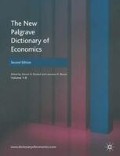Abstract
Consider the following choice problem, known as ‘Ellsberg’s three-colour urn example’, or simply the ‘Ellsberg paradox’ (Ellsberg, 1961). An urn contains 30 red balls, and 60 green and blue balls, in unspecified proportions; subjects are asked to compare (a) a bet on a red draw with a bet on a green draw, and (b) a bet on a red or blue draw with a bet on a green or blue draw. If the subject wins a bet, she receives ten dollars; otherwise, she receives zero dollars. To model this situation as a problem of choice under uncertainty, let the state space be {S r , S g , S b } in obvious notation, and consider the bets in Figure 1.
Preview
Unable to display preview. Download preview PDF.
Bibliography
Aliprantis, C. and Border, K. 1994. Infinite Dimensional Analysis. Berlin: Springer Verlag.
Anscombe, F. and Aumann, R. 1963. A definition of subjective probability. Annals of Mathematical Statistics 34, 199–205.
Bewley, T. 2002. Knightian decision theory: Part I. Decisions in Economics and Finance 25(2), 79–110.
Camerer, C. and Weber, Martin. 1992. Recent developments in modeling preferences: uncertainty and ambiguity. Journal of Risk and Uncertainty 5, 325–70.
Casadeus-Masanell, R., Klibanoff, P. and Ozdenoren, E. 2000. Maxmin expected utility over savage acts with a set of priors. Journal of Economic Theory 92, 33–65.
Chew, H. and Karni, E. 1994. Choquet expected utility with a finite state space: commutativity and act-dependence. Journal of Economic Theory 62, 469–79.
Choquet, G. 1953. Theory of capacities. Annales de l’Institut Fourier (Grenoble) 5, 131–295.
Dempster, A. 1968. A generalization of Bayesian inference. Journal of the Royal Statistical Society, Series B 30, 205–47.
Ellsberg, D. 1961. Risk, ambiguity, and the Savage axioms. Quarterly Journal of Economics 75, 643–69.
Epstein, L. 1999. A definition of uncertainty aversion. Review of Economic Studies 66, 579–608.
Epstein, L. and Schneider, M. 2001. Recursive multiple-priors. Journal of Economic Theory 113, 1–31.
Epstein, L. and Zhang, J. 2001. Subjective probabilities on subjectively unambiguous events. Econometrica 69, 265–306.
Ergin, H. and Gul, F. 2004. A subjective theory of compound lotteries. Mimeo. Econometric Society 2004 North American Summer Meetings, No. 152.
Ghirardato, P., Maccheroni, F. and Marinacci, M. 2004. Differentiating ambiguity and ambiguity attitude. Journal of Economic Theory 118, 133–73.
Ghirardato, P., Maccheroni, F., Marinacci, M. and Siniscalchi, M. 2003. A subjective spin on roulette wheels. Econometrica 71, 1897–908.
Ghirardato, P. and Marinacci, M. 2002. Ambiguity made precise: a comparative foundation. Journal of Economic Theory 102, 251–89.
Gilboa, I. 1987. Expected utility with purely subjective non-additive probabilities. Journal of Mathematical Economics 16, 65–88.
Gilboa, I. and Schmeidler, D. 1989. Maxmin expected utility with a non-unique prior. Journal of Mathematical Economics 18, 141–53.
Gilboa, I. and Schmeidler, D. 1993. Updating ambiguous beliefs. Journal of Economic Theory 59, 33–49.
Jaffray, J.-Y. 1994. Dynamic decision making with belief functions. In Advances in the Dempster- Shafer Theory of Evidence, ed. R. Yager, J. Kacprzyk and M. Fedrizzi. New York: Wiley.
Klibanoff, P. 2001. Characterizing uncertainty aversion through preference for mixtures. Social Choice and Welfare 18, 289–301.
Klibanoff, P., Marinacci, M. and Mukerji, S. 2005. A smooth model of decision making under ambiguity. Econometrica 73, 1849–92.
Luce, R. and Raiffa, H. 1957. Games and Decisions. New York: Wiley.
Machina, M. and Schmeidler, D. 1992. A more robust definition of subjective probability. Econometrica 60, 745–80.
Savage, L. 1954. The Foundations of Statistics. New York: Wiley.
Schmeidler, D. 1986. Integral representation without additivity. Proceedings of the American Mathematical Society 97, 255–61.
Schmeidler, D. 1989. Subjective probability and expected utility without additivity. Econometrica 57, 571–87.
Shafer, G. 1976. A Mathematical Theory of Evidence. Princeton, NJ: Princeton University Press.
Siniscalchi, M. 2006. A behavioral characterization of plausible priors. Journal of Economic Theory 128(1), 91–135.
Wang, G. 2003. Conditional preferences and updating. Journal of Economic Theory 108, 286–321.
Editor information
Copyright information
© 2008 Palgrave Macmillan, a division of Macmillan Publishers Limited
About this entry
Cite this entry
Siniscalchi, M. (2008). Ambiguity and Ambiguity Aversion. In: Durlauf, S.N., Blume, L.E. (eds) The New Palgrave Dictionary of Economics. Palgrave Macmillan, London. https://doi.org/10.1007/978-1-349-58802-2_36
Download citation
DOI: https://doi.org/10.1007/978-1-349-58802-2_36
Published:
Publisher Name: Palgrave Macmillan, London
Print ISBN: 978-0-333-78676-5
Online ISBN: 978-1-349-58802-2

